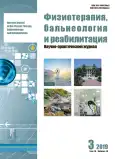Оценка критериев ультразвуковой диагностики кожи как прогностический фактор профилактики нежелательных явлений после монополярного радиоволнового воздействия
- Авторы: Аксененко И.П.1, Герасименко М.Ю.2
-
Учреждения:
- Российская медицинская академия непрерывного профессионального образования Минздрава России
- Клиника эстетической медицины
- Выпуск: Том 18, № 3 (2019)
- Страницы: 140-144
- Раздел: Оригинальные исследования
- URL: https://journals.rcsi.science/1681-3456/article/view/62570
- DOI: https://doi.org/10.17816/1681-3456-2019-18-3-140-144
- ID: 62570
Цитировать
Полный текст
Аннотация
В исследовании представлены данные ультразвукового исследования кожи пациентов в динамике до и после воздействия монополярного радиочастотного метода.
Под наблюдением находился 41 пациент в возрасте от 38 до 45 лет, которые были разделены на две группы в соответствии с типом кожи: деформационным или мелкоморщинистым. В обеих группах проводилось однократное воздействие с помощью монополярного радиочастотного метода на аппарате Thermage по утвержденному протоколу работы в области лица 1200 импульсов. Объективные методы исследования включали ультразвуковую диагностику до лечения, через 1, 3 и 6 мес после лечения, а также определение дерматологического индекса качества жизни. Оценка результатов проводилась через 1, 3 и 6 мес после проведенного лечения. Полученные данные ультразвукового исследования кожи показали, что наилучшие изменения в дерме высокочастотный радиоволновый метод давал при более выраженной исходной толщине дермы и был более эффективен при деформационном типе старения кожи по сравнению с мелкоморщинистым.
Ключевые слова
Полный текст
Открыть статью на сайте журналаОб авторах
Ирина Павловна Аксененко
Российская медицинская академия непрерывного профессионального образования Минздрава России
Email: mgerasimenko@list.ru
ORCID iD: 0000-0003-3602-594X
SPIN-код: 8172-4573
Россия, Москва
Марина Юрьевна Герасименко
Клиника эстетической медицины
Автор, ответственный за переписку.
Email: mgerasimenko@list.ru
ORCID iD: 0000-0002-1741-7246
SPIN-код: 7625-6452
д.м.н., проф.
Россия, МоскваСписок литературы
- Неробеев А.И., Малаховская В.И., Аликова А.В. Возможности применения минимально инвазивного радиочастотного лифтинга в коррекции инволюционных изменений мягких тканей лица и шеи. Вестник эстетической медицины. 2013;1:44–50.
- Abraham M.T., Ross E.V. Current concepts in nonablative radiofrequency rejuvenation of the lower face and neck. Facial Plast Surg. 2005;21:65–73. doi: 10.1055/s-2005-871765.
- Finzi E., Spangler A. Multipass vector (mpave) technique with nonablative radiofrequency to treat facial and neck laxity. Dermatol Surg. 2005;31:916–922. doi: 10.1111/j.1524-4725.2005.31805.
- Weiss R.A., Weiss M.A., Munavalli G., et al. Monopolar radiofrequency facial tightening: a retrospective analysis of efficacy and safety in over 600 treatments. J Drugs Dermatol. 2006;5:707–12.
- Fritz M., Counters J.T., Zelickson B.D. Radiofrequency treatment for middle and lower face laxity. Arch Facial Plast Surg. 2004;6:370–3.
- De Felipe I., Del Cueto S.R., Perez E., et al. Adverse reactions after non-ablative radiofrequency: follow-up of 290 patients. J Cosmet Dermatol. 2007;6:163–6. doi: 10.1111/j.1473-2165.2007.00322.x.
- De Felipe I., Redondo P. Animal model to explain fat atrophy using nonablative radiofrequency. Dermatol Surg. 2007;33:141–5. doi: 10.1111/j.1524-4725.2006.33031.x.
- Петрова Г.А., Горская А.А., Петрова К.С. и др. Морфофункциональная оценка эффективности радиочасттного лифтинга. Вестник эстетической медицины. 2011;4:80–84.
Дополнительные файлы






